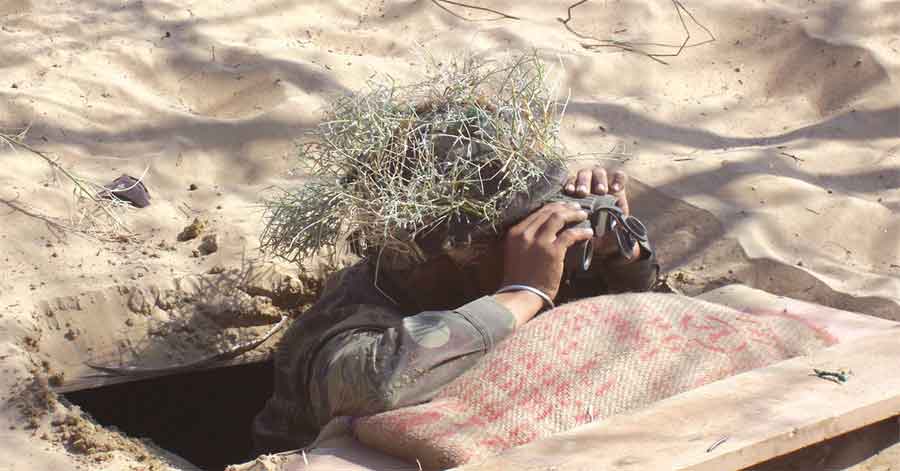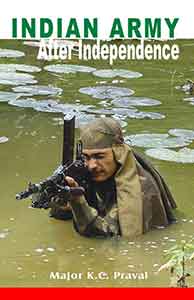“Future conflicts are going to be short but intense wars before international pressure forces a cease fire. Both sides will try to gain maximum territory to use as a bargaining counter in subsequent negotiations.” This has been (or possibly still is) the standard preamble to all tactical exercises. Concept of limited war is not just the basis of operations oriented exercises but consciously or sub-consciously forms the basis of strategic planning.
In 21st century after a five decade long practice this has become the accepted mythology or shall one say the ‘Holy Cow’ of strategic discussions/thinking in India.
Such a major modification of theories of war ought to have been proceeded by through discussion/debate of which the author is unaware. Over time it has assumed the role of being a virtual principle of war in Indian context.
In 21st century after a five decade long practice this has become the accepted mythology or shall one say the ‘Holy Cow’ of strategic discussions/thinking in India.
Mythology is not pure fiction but neither is it history. Unlike fiction there is a kernel of truth that is embellished with imagination. Over a period of time these become so imbedded in public mind that mythologies are then confused with history by some while others denounce it as pure fiction. Truth lies somewhere in the middle. Concept of limited war is no exception to this dilemma of truth (history) turning into mythology.
Even in pre-nuclear weapons era, wars were limited by the means of destruction available and limit on weapon ranges. There were also geographical limits due to these very factors. In addition, ethics/morality and tradition limited violence in war, be it sparing women and children in ancient times or not bombing hospitals in modern era warfare! Yet at the philosophical level, as so aptly put by Clausewitz, theoretically wars of total violence is the norm. He warned,
“Woe to the side that with shackled military takes on a foe that like a forces of nature know no other law than its own power” (paraphrased)
The term ‘limited war’ entered the strategic debate after the advent of nuclear weapons. As nuclear deterrence became mutual and world became aware of long term effects like ‘nuclear winter’, nuclear war became unthinkable. While the advances in technology indeed made an all-out war including use of nuclear weapons politically unacceptable, the causes and geo-politics remained unchanged and conflicts in world continued. Thus defined, limited war came to subsume under it all conflicts short of nuclear war.
The term ‘limited war’ entered the strategic debate after the advent of nuclear weapons. As nuclear deterrence became mutual and world became aware of long term effects like ‘nuclear winter’, nuclear war became unthinkable.
Within this classification there were two major divisions, a limited conventional conflict, mainly between non-nuclear nations and insurgencies or ‘People’s War’. After the demise of Communism these conflicts have been re-name as ‘low intensity conflicts’.
This classification, especially of the wars between two non-nuclear powers, was misleading. What was a ‘limited war’ from Super Power’s perspective, say the several Arab Israel wars (1948,1967 or 1973) were ‘Total Wars’ from the perspectives of the combatants themselves. They used all the means available to them and their aim was also destruction of enemy. It is like a difference in the perspective of a Hen and a Pig when they offer an Egg and Ham breakfast to their masters! For the Hen it was mere involvement while for a Pig it was ‘total commitment’.
Countries like India that fought at least four conventional wars with Pakistan and China in pre-nuclearization era ie before 1998, the similar logic ought to apply. While these were indeed limited wars for Super Powers, they were total wars for us. But this fact has not been understood at the strategic level in India. We mistook the ‘limited means’ for fighting for a limited aim. India (and China to an extent in 1962) had limited aims. In 1947 and 1965 it was to stop aggression in Kashmir and in 1971 it was liberation of Bangladesh.
Since then India has been essentially ‘reacting’ to initiatives by its enemies. Mere reaction to the enemy action and trying to gain an advantageous position cannot be a war aim. What it did to us is that in 1965 we missed many strategic opportunities to earn a victory like the push to Lahore. In 1971 the thinking dominated by ‘limited aim’ thinking lost out on the chance to score major gains in Jammu and Kashmir and strengthen our defensive position. Instead of concentrating forces in the West on J&K we launched minor forays across International border.
In 1971 the thinking dominated by ‘limited aim’ thinking lost out on the chance to score major gains in Jammu and Kashmir and strengthen our defensive position.
It is scarcely appreciated that whether in limited war or all-out war at tactical level for the fighting men it is a ‘total’ conflict-there are no half measures at tactical level. But the lack of clarity and vague aim at strategic level has crucial detrimental effect on morale at the tactical level. It is Napoleon who said that in war, moral (or morale) to the physical is like three is to one.
Another form of limited war is variously called ‘insurgency’, people’s war or low intensity conflict. Here again, due to political factors like concern for human rights etc, one side, that is counter insurgents do not use the full spectrum of weapons at their command. Weapons like tanks, artillery or air power are avoided so as to minimize co-lateral damage and casualties. The counter insurgent’s, besides limit on means; also have a limited aim of getting the insurgents to give up violence while the insurgents aim at total war and defeat of their opponents. There is even more misinformation about this form of limited war than the conventional one.
It is often unknown to the peace NGOs or judges and lay people that in this so called low intensity and limited conflicts, at the tactical level engagement, full force is used and rules of war apply.
There is no difference between an ambush, raid or patrolling in this so called low intensity conflict and regular war. Rules of war of total use of available force apply and not civil or criminal law. It is to protect the soldier from these consequences that legislation like the Armed Forces Special Powers Act 1956 has been enacted. Civil organizations or judiciary often lose sight of this very basic fact and are sometimes horrified at the killings that take place.
This lack of understanding of what low intensity wars in reality means, is the basis of many wrong actions by the society and judicial system against the law enforcing soldier.
In conclusion one can clearly state that limited wars are limited by the ‘means’ used in conflict, but within these limits either side or both sides may be fighting a total war. In a conflict that is stretched over long periods, like the insurgencies, the insurgents are fighting a total war while the counter insurgents have a limited aim.
In both these cases, often it is the side that has clear aim that often triumphs. This is a lesson worth learning in Indian context for much of our misfortune in past stems from this basic theoretical weakness.
References
- Kaplan Morton A. “Great Issues of International Politics”, Chato and Windus , New York.
- Blackett PMS, “Studies of War: Nuclear and Conventional”, Olive and Boyd, London 1962.
- Kahn Herman, “Thinking about the Unthinkable”, Wiedenfeld and Nicholson , London, 1962.
- Bottom Edgar, “The Balance of Terror”, Beacon Press, Boston, 1986.
- Osgood Robert E. “Limited War”, University of Chicago Press, Chicago, 1957.
- Griffith Samuel E. (Trans), M” MaoTseTung on Guerrilla War”, Holt, Rinehart & Winston, New York, 1961.
- Gallaghar CSM James J. “ Low Intensity Conflicts”, Lancer Pub, Delhi, 1994.
- Howard Michael, “ Studies in War and Peace”, chapter on Clauswits and Jomini. Murice Temple Smith, London, 1970.
- Athale Col Anil, “Counterinsurgency and Quest for Peace” Vij Books, New Delhi, 2012.







I fully agree with you.“Future conflicts are going to be short but intense wars before international pressure forces a cease fire. But the question is our defense officers are really thinking on those lines. I do not think so. They still thinking about conventional war using field guns , assault rifles , Mortar and not giving importance to Am munitions and weapons used. It also very important the speed with which it hits the targets. This is exactly we have achieved in the case of brahmos missiles After the invention of weapon detection radar it is dangerous to use field guns. Tanks, fighter planes, warships, Aircraft carriers and submarines are all weapon carrying vehicles. Our requirement of these vehicles should be based the effectiveness of ammunition and weapons used to destroy enemy installations and enemy formations near the LOC to gain maximum territory to use as a bargaining counter in subsequent negotiations. A good manger will try to maintain minimum inventory of equipments to control expenditure. This concept is not there at all in the Army. So majority of top ranking defense officers whether in Army, IAF and Navy are poor managers . They always think that if we can keep more number of weapon carrying vehicles than the enemy they can win the war. After the 1971 war PAF said that India achieved Air superiority because the bombs used to damage Air field found to ineffective. IAF was able to repair the run ways in short time. My suggestion is to use Computer to find out the requirement of vehicles and ammunition by developing software. Requirement of weapon carrying vehicles should be calculated on the basis of destructive power of the weapon. USA had used only two planes to drop atom bombs in world war II. A thermonuclear weapon weighing little more than 2,400 pounds (1,100 kg) can produce an explosive force comparable to the detonation of more than 1.2 million tons (1.1 million tonnes) of TNT.[2].. It is very easy to calculate the requirement using software’s. We are a super power in the missile technology and we have some best missiles in the world. We know the destructive power of our missiles. We know the enemy installations and enemy formations in every sector along the LOC in the case of Pakistan and China. We have no plan to attack any other country like USA and western countries. We believe in “Lokah Samastah Sukhino Bhavantu”. Exact area can be found out using GPS. “GPS can calculate the area, and display the results in acres, square feet, square miles, hectares, or square kilometers.” Similarly we can find out how much area one particular missile can destroy. and percentage of Hit. ( The reported hit rate by USAF Mavericks was 80–90%, while for the USMC it was 60%.[2] ) Develop a suitable soft ware which can give the requirement if we feed these data in the Computer having varying percentage of hit. Computer will give the number of missiles required and how many sorties to be conducted if we use different types of fighter plane and missiles. This is the correct way to find out the requirement. For a manager, modernization means to reduce the inventory of equipments and increase production at lower cost. Different types of lathes were used to manufacture one machine part earlier. Where as one CNC machine will do the entire operation with less time and maintain far better quality. The machinist used to check the measurement using hand held gauges. One CNC machines will save operational time , space. and number of operators. Top Army officers should be given management training. It will be a great help to the nation if you can introduce inventory control in the defense forces.